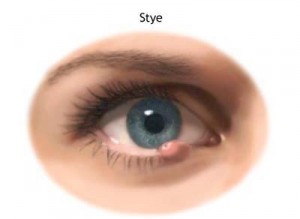Sty refers to a bacterial infection that affects a small gland in the eyelid, which releases fluid to keep the eye lubricated. Bacteria begin to proliferate in a gland when it gets obstruct with skin cells. The growth of bacteria may lead to inflammation of the eyelid, thus, resulting in sty. Stys usually occur at the edge of the eyelid – where the eyelids connect. A sty nearer to the center of the eyelid is called a hordeolum. If left untreated, a hordeolum may turn into a painless lump called chalazion.
A person with a sty may have a swollen lump on his eyelid close to the eyelashes. He may also experience eye tenderness and pain in the eyelid. Sometimes pus may drain from the swollen lump as well.
Treatment measures involve regular gentle eyelid cleansing, antibiotic creams and warm compress. If the lump has pus, a minor surgery will be carried out to drain it.
Disclaimer: If you believe you have sty contact your doctor. This post is meant for learning purposes only. This topic is not covered in St Mark James first aid training, however, if you want to learn about other eye injuries and 
Signs and symptoms
- Swollen skin lump and tenderness of the eyelid
- Pain in the eyelid
- Redness of the eyelid
- Pus drainage form the eyelid
Treatment
Most stys disappear within a week, on their own. Follow these homecare steps to ease the symptoms of sty:
1. Treat symptoms of sty
- Apply a warm compress on the affected eyelid several times a day for 5 to 10 minutes. Do not re-use cloths that have been used to clean the eye. Gently compress the eyelid with a clean towel soaked in warm water or a clean washcloth. Keep your eyes closed while compressing. Avoid sharing towels with your family members
2. Protect the eyelid against further infection
- Keep the eyelid clean and avoid touching the eyelids, especially in public places. Wash your hands immediately after touching your eyes or cleaning it. Avoid contact with people with contaminated hands
- Avoid squeezing the sty to encourage drainage
- Avoid using contact lenses and eye make-up until the sty disappears
When to seek medical attention
Most cases of stys do not require a trip to the hospital. However, if you experience the following problems, seek help from your doctor:
- Sty does not disappear within 7 to 10 days
- Sty worsens even with home treatment or becomes more painful after several days
- Sty is accompanied with other symptoms such as fever and chills
- Sty is accompanied with vision problems such as blurry or dual vision
- You are suffering from recurrent stys
- You are suffering from other chronic diseases that may result in an abnormal immune system such as diabetes
- You have a suppressed immune system due to cancer treatment or organ transplant
Complications
The following are the complications that are associated with sty:
- Chalazion
- Eyelid cellulitis
- Entropion – abnormal growth of the eyelashes
- Periorbital cellulitis
Prevention
Follow these preventive steps to reduce the risk of sty:
- Keep your eyelids clean
- Remove contact lenses whenever not needed or before sleeping
- Remove eye makeup when it is not needed or at the end of the day, before sleeping
Learn More
To learn about other eye injuries and how to manage and recognize them sign up for St Mark James first aid and CPR courses with a provider near you – register here.
Related Video
http://www.youtube.com/watch?v=Xyu-GlpgCpQ
